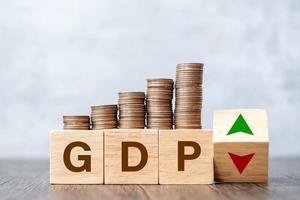“Explore the intricacies of India’s economic outlook for 2024-25, dissecting the conservative approach in the interim budget. Uncover the strategic nuances behind the 10.5 percent nominal GDP assumption and its far-reaching impact on fiscal health. Delve into the delicate interplay of real GDP growth, wholesale inflation, and the GDP deflator, shaping the nation’s economic trajectory. Join us on a journey of cautious optimism as we unravel the complexities steering India’s financial landscape towards growth and stability.”
In the realm of India’s economic trajectory for the fiscal year 2024-25, the recently presented interim budget has set the stage for an intriguing journey, marked by a seemingly conservative approach. With real GDP growth projections ranging from 6 to 7 percent, the finance ministry’s scenario planning unfolds against the backdrop of uncertainties, creating a buzz within financial circles.

Diving into the intricacies of the budget, the nominal GDP growth projection of 10.5 percent takes center stage, underpinned by three distinct scenarios envisaged by the finance ministry. One scenario envisions a real GDP growth as modest as 6 percent for the upcoming financial year, a figure that has raised eyebrows and sparked conversations among experts.
Understanding the dynamics at play, the GDP deflator emerges as a crucial metric, encapsulating the difference between real and nominal growth. This deflator, influenced by wholesale and retail inflation, holds the key to shaping India’s economic landscape. The delicate dance between inflation rates becomes apparent, with the deflator poised to shift based on varying scenarios of economic growth.
The finance ministry’s contemplation of a real GDP growth ranging from 6 to 7 percent indicates a conscious decision to adopt a conservative stance, deviating from the widespread expectation of a closer 7 percent growth rate. The balancing act becomes even more nuanced as the deflator is speculated to hover between 3.5 to 4.5 percent for FY24-25.

Wholesale inflation, a dominant factor in determining the GDP deflator, has experienced fluctuations, reaching a nine-month high in December 2023. The intricate interplay between wholesale and retail inflation becomes evident, with the former exerting a more substantial influence. Against this backdrop, the government’s decision to factor in a potential 6 percent real GDP growth reflects a strategic move to navigate potential economic challenges.
While the interim budget refrains from explicitly forecasting real GDP growth, a report from the finance ministry on January 29 hints at an optimistic outlook, projecting a growth rate close to 7 percent in 2024-25. The report attributes this growth to the robust strength of domestic demand, driving the economy in the preceding three years.

As the spotlight shifts to the nominal GDP growth assumption for 2024-25, the ramifications become far-reaching, determining estimates such as fiscal deficit and tax collections. A higher nominal GDP growth not only impacts the fiscal deficit but also plays a pivotal role in shaping the economic narrative, offering a positive trajectory for the nation’s financial health.
Defending the choice of a 10.5 percent nominal GDP assumption, Economic Affairs Secretary Ajay Seth emphasized the realism embedded in this figure. Drawing parallels to the previous year’s projections versus actual figures, Seth suggests that a 10.5 percent nominal growth rate stands as a reasonable and pragmatic estimate for the upcoming fiscal year.
In retrospect, 2023-24 witnessed a slowdown in nominal GDP growth, registering at 8.9 percent, a significant deviation from the central government’s initial projection of 10.5 percent. The divergence was attributed to the normalization of the base effect and subdued wholesale price index (WPI) inflation, influenced by cooling global commodity prices.
Looking ahead, the normalization of the base effect and the anticipation of rising WPI inflation indicate a potential rebound in nominal growth for the Indian economy. The pivotal role of wholesale inflation, tethered to nominal GDP growth, positions India’s economic trajectory on an upward curve, provided inflationary pressures continue to gain momentum.

Crucially, higher nominal GDP growth becomes a linchpin for enhancing the central government’s financial standing. In a scenario where committed expenditures such as interest payments, salaries, and pensions remain rigid, and capital expenditure remains a focal point, a boost in nominal GDP offers a pathway to bolster the nation’s fiscal health.
In conclusion, the intricacies of India’s economic landscape for the fiscal year 2024-25 unfold as a narrative of cautious optimism. The finance ministry’s contemplation of a range of real GDP growth scenarios, coupled with the anticipation of a 10.5 percent nominal GDP growth, underscores a strategic approach to navigate the complex web of economic variables. As the nation awaits the unfolding chapters of its economic journey, the resilience and adaptability embedded in the interim budget set the stage for a compelling narrative of growth and stability.
Disclaimer:
The information provided in this blog is for informational purposes only and should not be considered as financial or investment advice. The content is based on publicly available information and analysis as of the specified date. The economic landscape is subject to change, and readers are encouraged to conduct their own research and seek professional advice before making any financial decisions. The author and the platform disclaim any liability for any loss or damage arising directly or indirectly from the use of or reliance on the information provided in this blog. All views expressed are those of the author and do not necessarily represent the views of any affiliated organizations or institutions.





Thanks for the tips about credit repair on your blog. Some tips i would offer as advice to people should be to give up a mentality that they’ll buy at this moment and pay back later. Like a society all of us tend to make this happen for many things. This includes vacations, furniture, and also items we’d like. However, you’ll want to separate your current wants from the needs. When you are working to improve your credit rating score make some trade-offs. For example you are able to shop online to save money or you can visit second hand outlets instead of expensive department stores to get clothing.